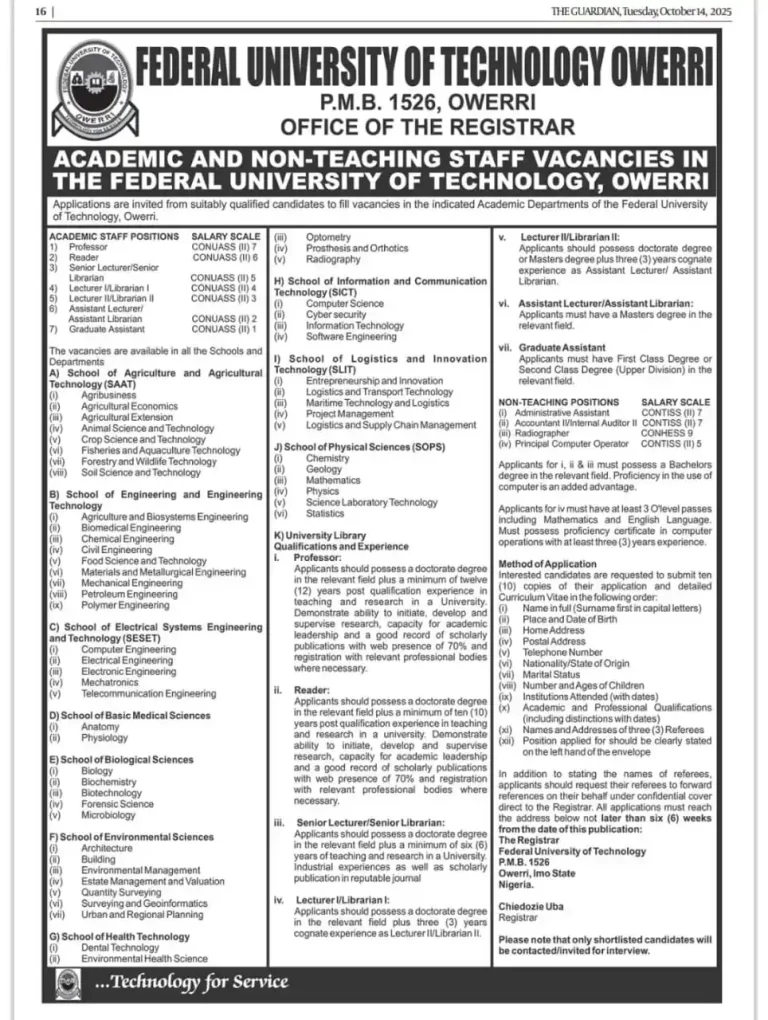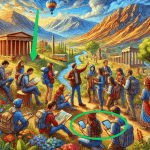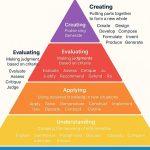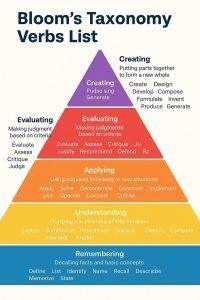
Bloom’s Taxonomy Verbs List: Practical Application of Cognitive Learning Levels
Bloom’s Taxonomy Verbs List: A Complete Guide to Cognitive Learning Levels
Introduction
If you’re a teacher, curriculum designer, or EdTech enthusiast, understanding the Bloom’s taxonomy verbs list can dramatically improve how you write learning objectives, design meaningful classroom activities, and assess student learning effectively.
This expanded guide breaks down Bloom’s six levels of cognitive learning—from foundational recall to advanced creation—and includes real-world teaching examples, EdTech tools, sample objectives, and FAQs. This content is perfect for lesson planning, LMS integration, and digital education.
📚 What Is Bloom’s Taxonomy?
Bloom’s Taxonomy is a hierarchical classification of thinking skills that educators use to structure curriculum goals, lessons, and assessments. Developed in 1956 by Benjamin Bloom and revised in 2001 by Anderson & Krathwohl, it provides a scaffold for promoting deeper learning and critical thinking.
The six revised levels are:
- Remembering
- Understanding
- Applying
- Analyzing
- Evaluating
- Creating

Bloom’s Taxonomy Verbs List
Each level is associated with action verbs that describe what learners should be able to do. These verbs are essential for writing measurable learning outcomes and ensuring educational alignment.
Why Use Bloom’s Taxonomy Verbs List?
Using Bloom’s taxonomy verbs ensures your objectives are measurable, clear, and skill-based. Whether you’re writing a K-12 lesson plan, developing an online course, or building an LMS module, these verbs:
- Help define the depth of learning expected
- Make assessments more targeted
- Promote higher-order thinking
- Improve student engagement
Let’s explore each level in detail, with key verbs, classroom examples, and digital tools.
#1. Remembering — Foundation Level
What It Involves: Recalling facts, terms, basic concepts, or answers.
Key Verbs: Define, List, Identify, Name, Recall, Describe, Memorize, State
Example Objective: Students will be able to list the planets in the solar system.
Tools: Flashcards (Quizlet), Multiple Choice Quizzes (Kahoot!), Digital note apps (Notion)
Teaching Tip: Use quick recall activities like games or oral questioning to reinforce this level.
#2. Understanding — Grasping Meaning
What It Involves: Explaining ideas or concepts.
Key Verbs: Explain, Summarize, Paraphrase, Discuss, Classify, Compare, Interpret, Predict
Example Objective: Students will summarize the main idea of a story in their own words.
Tools: Padlet for reflections, Edmodo for discussions, Google Slides for visual summaries
Classroom Application: Encourage think-pair-share and guided group discussions.
#3. Applying — Using Knowledge in Context
What It Involves: Using information in new situations.
Key Verbs: Apply, Solve, Demonstrate, Construct, Implement, Use, Operate, Calculate
Example Objective: Students will apply the Pythagorean theorem to solve real-world math problems.
Tools: Virtual Labs, GeoGebra, Scratch (for coding tasks)
Real Scenario: In a STEM class, learners use formulas to design simple bridge models.
#4. Analyzing — Breaking Things Down
What It Involves: Distinguishing between different parts and understanding relationships.
Key Verbs: Analyze, Categorize, Differentiate, Examine, Investigate, Compare, Contrast, Outline
Example Objective: Students will compare and contrast two historical events.
Tools: Canva for Venn diagrams, Jamboard for collaborative breakdowns, Miro for mapping
Teacher Strategy: Use concept maps and document-based questions (DBQs).
#5. Evaluating — Making Judgments
What It Involves: Justifying decisions or opinions based on criteria.
Key Verbs: Evaluate, Assess, Critique, Judge, Justify, Recommend, Defend, Rate
Example Objective: Students will evaluate the effectiveness of renewable energy sources.
Tools: Google Forms for peer assessment, Flipgrid for video critiques, Rubrics in Google Classroom
Use Case: In literature, students defend the moral choices of a character in debate format.
#6. Creating — Synthesizing New Ideas
What It Involves: Combining elements to form new structures, ideas, or products.
Key Verbs: Create, Design, Develop, Compose, Formulate, Invent, Produce, Generate
Example Objective: Students will design an app prototype that solves a community problem.
Tools: Canva, Adobe Express, Figma, Google Sites, TinkerCAD
Student Task: In a Capstone Project, students invent solutions and present them as portfolios.
Visualize It: The Bloom’s Taxonomy Pyramid
Think of Bloom’s levels as steps on a staircase or a learning pyramid:
- Base: Remembering
- Next Steps: Understanding → Applying → Analyzing
- Top: Evaluating → Creating
Each level supports deeper cognitive development, with measurable verbs helping guide lesson structure and assessments.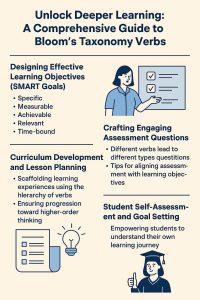
Sample Lesson Objectives Using Bloom’s Verbs
| Level | Sample Objective |
|---|---|
| Remember | List 5 causes of air pollution |
| Understand | Summarize a chapter using your own words |
| Apply | Use MS Excel to create a basic budget table |
| Analyze | Contrast the themes of two novels |
| Evaluate | Justify the selection of a political leader |
| Create | Compose an original poem about climate change |
Free EdTech Tools for Each Level
| Bloom’s Level | Recommended Tools |
|---|---|
| Remembering | Quizlet, Kahoot!, Blooket |
| Understanding | Padlet, Google Slides, Edmodo |
| Applying | Scratch, GeoGebra, Minecraft Education |
| Analyzing | Miro, Canva, Lucidchart |
| Evaluating | Flipgrid, Peergrade, Rubrics |
| Creating | Canva, Figma, TinkerCAD, Adobe Express |
❌ Common Mistakes Teachers Make with Bloom’s Taxonomy
- Overloading objectives with multiple verbs from different levels
- Using vague verbs like “learn” or “understand”
- Not aligning assessments with cognitive levels
- Skipping higher-order tasks due to time constraints
Tip: Always align your assessments and activities with the verbs in your objective.
A public secondary school embed Bloom’s Taxonomy in their weekly digital learning plan. Teachers can use WhatsApp and Google Docs to push activities structured by Bloom’s levels:
- Monday: Remembering facts (WhatsApp quizzes)
- Tuesday: Summarizing notes
- Wednesday: Problem-solving tasks
- Thursday: Analysis of texts or graphs
- Friday: Creative writing or digital art tasks
This can structure improve student participation by 35% over six weeks.
❓Bloom’s Taxonomy Verbs List
Q: Can I use Bloom’s verbs in online learning?
A: Absolutely! Tools like Google Classroom and LMS platforms support objective-based modules.
Q: Is there a PDF version of Bloom’s taxonomy verbs list?
A: Yes! [Download your infographic or printable chart here.]
Q: Are these verbs suitable for adult learners or corporate training?
A: Yes, Bloom’s taxonomy applies to all learning contexts, including workplace and vocational training.
Q: How often should I update learning objectives?
A: At the start of each unit or after a curriculum review.
Q: What if students are stuck at the lower levels?
A: Scaffold tasks gradually. Start with remembering and build up to creating through formative feedback.
Final Thoughts
This extended Bloom’s taxonomy verbs list guide is your toolkit for crafting deeper, smarter learning experiences. Whether you’re writing a lesson plan, building an EdTech platform, or coaching fellow educators, these verbs make learning intentional, trackable, and impactful.
Keep this guide bookmarked, download the infographic, and try integrating one new verb level each week into your classroom or course module.
For more teaching tools, visit edtechnology.com.ng or request a custom lesson plan template.
See our Bloom’s taxonomy verbs list in practical you can also download PDF format as compiled by edtech insights
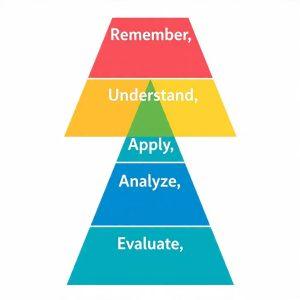
Let’s now present the simplified and complete version of the guide, with:
You can download Bloom’s taxonomy verbs list with practical examples here
https://edtechnology.com.ng/wp-content/uploads/2025/07/Blooms-taxonomy-verbs-list1-1.pdf
✅ Topics for each lesson
✅ Full structure (verbs, objectives, activities, assessments)
✅ Nigerian curriculum relevance (NERDC-style topics for both Primary and Secondary)
1. Remembering — Knowing Facts
What it means: Remembering facts, names, and definitions.
When to use: At the beginning of a topic, or during revision.
🔹 Action Verbs: Name, List, Say, Match, Recall, Identify
Primary School
- Subject: Basic Science
- Class: Primary 3
- Topic: Parts of a Plant
- Objective: Pupils will name and match parts of a plant like leaf, stem, root, flower.
- Activity: Teacher shows a big plant picture. Pupils shout the part names or use flashcards to match names to pictures.
- Assessment: Oral quiz and a worksheet with “Label the Plant” diagram.
Secondary School
- Subject: Civic Education
- Class: JSS 1
- Topic: Rights of a Citizen
- Objective: Students will recall and define at least five rights of a Nigerian citizen.
- Activity: Use cards with “Right to Life,” “Freedom of Speech,” etc. Students match each right to its meaning.
- Assessment: 10-question multiple-choice quiz + short answers (e.g. “What is the Right to Education?”)
2. Understanding — Explaining Ideas
What it means: Show you understand something by explaining it in your own words.
When to use: After a story, a passage, or an explanation.
🔹 Action Verbs: Explain, Tell, Paraphrase, Talk about, Describe
Primary School
- Subject: English Studies
- Class: Primary 4
- Topic: Morals in Stories
- Objective: Pupils will explain what lesson they learned from a short story.
- Activity: Read a folk tale like The Tortoise and the Hare. Ask pupils what they learned. Let them draw and explain.
- Assessment: Drawing with 1–2 sentences like “I learned that lying is bad.”
Secondary School
- Subject: English Language
- Class: JSS 2
- Topic: Reading Comprehension
- Objective: Students will summarize the main ideas in a short passage.
- Activity: In groups, students read and discuss. Then each writes a short summary.
- Assessment: Teacher checks if the summaries cover key points and use correct grammar
3. Applying — Using What You Learned
What it means: Solve problems or do something using your knowledge.
When to use: During classwork, games, or real-life examples.
🔹 Action Verbs: Use, Solve, Show, Try, Demonstrate
Primary School
- Subject: Mathematics
- Class: Primary 5
- Topic: Word Problems on Money
- Objective: Pupils will solve problems like buying/selling with naira.
- Activity: Create a mini market in class. Pupils act as buyers and sellers. Ask: “If Chika buys 3 mangoes at ₦50 each, how much is that?”
- Assessment: Short worksheet with 3–5 word problems.
Secondary School
- Subject: Basic Science
- Class: JSS 2
- Topic: Water Purification
- Objective: Students will build and test a simple water filter.
- Activity: In groups, they use sand, charcoal, and bottles to filter water.
- Assessment: Teacher checklist (Did water change? Did they follow steps? Group score.)
4. Analyzing — Breaking Things Down
What it means: Compare, find patterns, or explain how things are different or connected.
When to use: For discussions, charts, or deeper thinking.
🔹 Action Verbs: Compare, Group, Find differences, Break down
Primary School
- Subject: Social Studies
- Class: Primary 6
- Topic: Family Types
- Objective: Pupils will compare traditional and modern families.
- Activity: Show pictures of extended and nuclear families. Pupils draw a T-chart to list what’s the same and what’s different.
- Assessment: Group presentations + short paragraph on “My family type.”
Secondary School
- Subject: Literature in English
- Class: SS 2
- Topic: Characters in a Novel
- Objective: Students will compare two characters in a novel like Things Fall Apart.
- Activity: Use a Venn diagram to compare Okonkwo and Obierika.
- Assessment: Short essay explaining one similarity and one difference between them.
5. Evaluating — Making Judgments
What it means: Give your opinion and explain why you think it’s right.
When to use: During debates, opinion writing, or project feedback.
🔹 Action Verbs: Judge, Defend, Choose, Agree/Disagree, Recommend
Primary School
- Subject: Moral Instruction
- Class: Primary 5
- Topic: Making Good Choices
- Objective: Pupils will say if a character made a good or bad decision and why.
- Activity: Read a story. Pupils pair up and talk about the character’s action.
- Assessment: Write 1–2 lines: “He did the right thing because…”
Secondary School
- Subject: Basic Technology
- Class: JSS 3
- Topic: Solar vs Generator
- Objective: Students will judge which energy source is better and give reasons.
- Activity: Group debate: “Solar is better than Generator.”
- Assessment: Teacher scores using a rubric: points for clear points, teamwork, and facts.
6. Creating — Making Something New
What it means: Use what you’ve learned to build, draw, write, or design something new.
When to use: At the end of a topic or for projects.
🔹 Action Verbs: Create, Build, Make, Plan, Draw, Design
Primary School
- Subject: Creative Arts
- Class: Primary 4
- Topic: Community Hygiene
- Objective: Pupils will make a hygiene poster.
- Activity: In groups, they draw posters with messages like “Wash Your Hands.”
- Assessment: Poster walk + voting for best drawing/message.
Secondary School
- Subject: Civic Education
- Class: SS 3
- Topic: Sustainable Living
- Objective: Students will come up with a new idea to help their local community.
- Activity: In groups, students will create a simple poster or skit showing how they can help solve a problem in their area (e.g., keeping the environment clean, helping older people, or reducing noise).
- Assessment: Presentation + evaluation form (Is it creative? Clean? Useful?)
Summary Table
| Level | What It Means | Good For |
|---|---|---|
| Remembering | Saying facts and names | Starting a topic or doing revision |
| Understanding | Explaining in your words | Telling stories, summaries, morals |
| Applying | Using what you know | Solving problems, doing tasks |
| Analyzing | Finding patterns | Charts, comparisons, Venn diagrams |
| Evaluating | Giving opinions | Debates, judgments, choices |
| Creating | Making new things | Posters, models, end-of-term projects |
Check our well detailed lesson plan sample check
https://edtechnology.com.ng/wp-content/uploads/2025/07/Blooms-taxonomy-verbs-list1-1.pdf



